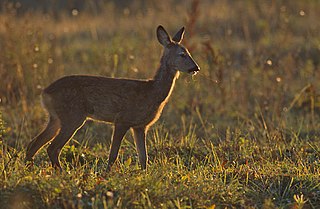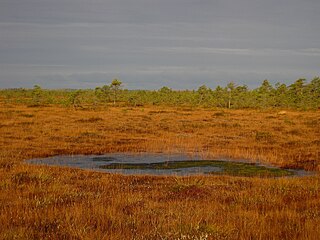
Nigula Nature Reserve is a nature reserve situated in South-West of Estonia, in Häädemeeste and Saarde parishes of Pärnu County. It has an area of 63.98 km². Nigula nature reserve is one of the oldest bog reserves in Estonia. It is established to protect the Nigula Bog and its surrounding forests in their natural state.

Elizabeth and Middleton Reefs Marine National Park Reserve is a former marine protected area consisting of waters around Elizabeth and Middleton reefs located at the south-eastern end of the Coral Sea Islands, an Australian territory in the Coral Sea. It was incorporated into the new Lord Howe Commonwealth Marine Reserve in December 2012. The two reefs also form a Ramsar site, having been listed as Ramsar Site 1223, on 21 October 2002, under the Ramsar Convention as a wetland of international importance.

Los Flamencos National Reserve is a nature reserve located in the commune of San Pedro de Atacama, Antofagasta Region of northern Chile. The reserve covers a total area of 740 square kilometres (290 sq mi) in the Central Andean dry puna ecoregion and consists of seven separate sections.
Matsalu National Park is a nature reserve and national park situated in Lääne and Pärnu Counties, Estonia. Matsalu National Park spans an area of 486.1 km2 (187.7 sq mi), comprising Matsalu Bay, the Kasari River delta, the village of Matsalu and surrounding areas.

Estonia is a small, heavily forested country situated on the Baltic Sea. It is a part of the Euro-Siberian region of terrestrial Palearctic realm, and the Temperate Northern Atlantic marine ecoregion.

Alam-Pedja Nature Reserve is the largest nature reserve in Estonia. It is a vast wilderness area which covers 342 km2 and consists of a complex of 5 large bogs separated by unregulated rivers, their floodplains, and extensive forests. The nature reserve aims to protect diverse ecosystems and rare species, mainly through preserving the natural development of forests and bogs and securing the continuing management of semi-natural floodplain grasslands.
Lake Warden is a salt lake in the Goldfields-Esperance region of Western Australia. It and its associated wetlands are protected in a nature reserve; they were recognised as being of international importance under the Ramsar Convention through designation of the Lake Warden System on 7 June 1990 as Ramsar Site 485. The lake is also a DIWA-listed wetland.
The Port Phillip Bay and Bellarine Peninsula Ramsar Site is one of the Australian sites listed under the Ramsar Convention as a wetland of international importance. It was designated on 15 December 1982, and is listed as Ramsar Site No.266. Much of the site is also part of either the Swan Bay and Port Phillip Bay Islands Important Bird Area or the Werribee and Avalon Important Bird Area, identified as such by BirdLife International because of their importance for wetland and waterbirds as well as for orange-bellied parrots. It comprises some six disjunct, largely coastal, areas of land, totalling 229 km2, along the western shore of Port Phillip and on the Bellarine Peninsula, in the state of Victoria. Wetland types protected include shallow marine waters, estuaries, freshwater lakes, seasonal swamps, intertidal mudflats and seagrass beds.

The Edithvale-Seaford Wetlands is a collection of principally freshwater swamps and marshlands totalling 261 hectares in southeastern Melbourne, Victoria, Australia, about 30 km (19 mi) southeast of Melbourne CBD. It is the largest natural wetland of its type in the Port Phillip and Western Port basins, and is all that remains of the historic Carrum Carrum Swamp, which once covered more than 4,000 hectares from present-day Mordialloc in the north to Frankston in the south.

The Coral Sea Reserves Ramsar Site comprises the 17,292 km2 of oceanic island and reef habitats within the former Coringa-Herald National Nature Reserve and the former Lihou Reef National Nature Reserve in the Australian Coral Sea Islands Territory.
The Forrestdale and Thomsons Lakes Ramsar Site comprises two separate nature reserves, totalling 754 ha in area, protecting two shallow fresh to brackish, seasonal lakes in a suburban and agricultural landscape in south-western Western Australia. It lies in the Swan Coastal Plain bioregion and is used mainly for birdwatching and walking. The site is recognised as being of international importance under the Ramsar Convention on Wetlands, under which it was designated Ramsar Site 481 on 7 June 1990.

Agusalu is a village in Alutaguse Parish, Ida-Viru County in northeastern Estonia. It is particularly known for the Agusalu Nature Reserve which encompasses a large proportion of the area. Its landscape is characterised by large bogs and is known for hosting the only system of continental sand dunes in Estonia.

Korgalzhyn State Nature Reserve is a nature reserve in Aqmola and Karaganda regions of Kazakhstan, located west of the city of Astana. It is part of the UNESCO heritage site Saryarka — Steppe and Lakes of Northern Kazakhstan, Ramsar site and biosphere reserve. It protects about 5432 km2 of lakes, steppes and semi deserts. The biggest lake is Lake Tengiz. Territory Korgalzhyn State nature reserve area of 543171 hectares is one integral portion located in the Steppe of central Kazakhstan region of the Indian and Siberian-East African migration routes of migratory birds and an important wetland of international importance, not only for Kazakhstan, but also for the whole of Asia. Extensive reserve waters provide the necessary living space in the largest Asian population of wetland birds.

Endla Nature Reserve is a nature reserve situated in central Estonia.

Muraka Nature Reserve is a nature reserve situated in eastern Estonia, in Ida-Viru County.
Sookuninga Nature Reserve is a nature reserve situated in south-western Estonia, in Pärnu County.
Laidevahe Nature Reserve is a nature reserve situated on Saaremaa in western Estonia, in Saare County.

Puhatu Nature Reserve is a nature reserve situated eastern Estonia, in Ida-Viru County.
Puhatu Wetland Complex is a bog in Ida-Viru County, Estonia. The bog extends from northern bank of Lake Peipus to Auvere-Narva line. It is part of Estonia's largest mire system Agusalu-Puhatu. The complex is protected.













